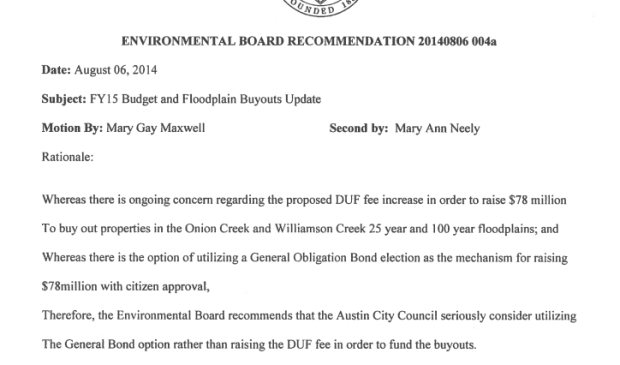Environmental Board rejects fee hike for buyouts
Monday, August 11, 2014 by
Elizabeth Pagano A plan to finance Onion Creek home buyouts through an increase in the city’s drainage utility fee found no support at the Environmental Board last week. Board members asked City Council members to find another way.
In a resolution passed Wednesday, Environmental Board members asked that Council “seriously consider utilizing the general bond option, rather than raising the drainage utility fee in order to fund the buyouts.”
Though it was not part of the resolution, Chair Mary Gay Maxwell referenced a recent court ruling that found that the city was currently applying drainage utility fees unfairly.
“The Watershed Protection Department is already under pressure, because that’s where they get their money for their budget every year,” said Maxwell. “That’s part of why I’m making the motion, which is to take the pressure off Watershed Protection, because they are already under duress from the court about their formula.”
Board members voted unanimously to support the recommendation that the city finance buyouts through a bond election. Board Member Marisa Perales was absent.
As part of her budget proposal, Watershed Protection Department Director Victoria Li said that she will be asking Council to approve one of two options to finance planned buyouts in the Onion Creek and Williamson Creek floodplains.
Instead of a bond election, the city could finance the buyouts through a certificate of obligation, which would use the city’s drainage utility fee to finance the debt. That would result in a 75 cent monthly increase in fees for the average resident, or about $9 annually. The 75 cent increase to finance the buyouts would be in addition to a proposed 60 cent increase proposed in this year’s budget.
On the other hand, if the buyouts are financed by Public Improvement Bonds, Austinites can expect to pay $11.79 more annually in property taxes or an average of less than $1 per month, according to city calculations. Voters would have to approve that option in a bond election. This is the option that Environmental Board members supported last week.
Li explained that her department still needs about $78 million to purchase homes that are at risk. That money would purchase 240 homes on Lower Onion Creek and 72 Williamson Creek properties in the 25-year floodplain.
The Watershed Protection Department will own and control land that the city buys. Li said the land could be used for recreation.
Maxwell pointed out that was already the case with homes that had already been purchased and destroyed by the city in the area.
“There is public access to these properties that belong to the city. They aren’t walled off from access by the public. I think that’s an important thing to bring out when we are talking about getting rid of a bunch of homes that have been destroyed by the flood. The city is buying those out, but there is also a public use that can be made of them. That makes it more understandable and more palatable,” said Maxwell.
Li explained that the buyout program had a long history. In 1998, an Army Corps of Engineers study determined there was no engineering solution that would mitigate flood risk in the lower Onion Creek area. The Corps recommended that the city relocate families in this area. By the time the Halloween Flood hit, the city had successfully relocated 323 families from that buyout program, which began in 1999.
That program used city and Federal Emergency Management Agency funds.
By the end of the year, the city expects to have completed the $23 million buyout of 116 homes substantially damaged by the Halloween flood.
The City Council has also approved a certificate of obligation bond of $35.5 million for the purchase of 140 homes in the 25-year floodplain.
The 2013 Halloween Flood, at its highest point, was more than 40 feet deep and had an estimated flow rate of 130,000 cubic feet per second. Four people died in the flood and about 750 homes were flooded, with 24 destroyed.
The department will also be asking for $1 million to do a study, continue outreach in the area and explore future engineering and buyout plans with the community.
You're a community leader
And we’re honored you look to us for serious, in-depth news. You know a strong community needs local and dedicated watchdog reporting. We’re here for you and that won’t change. Now will you take the powerful next step and support our nonprofit news organization?









